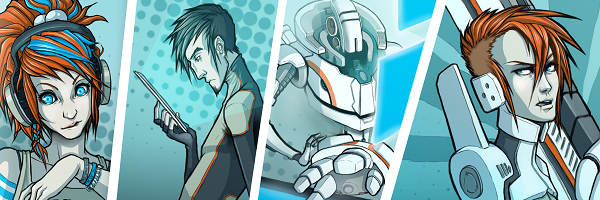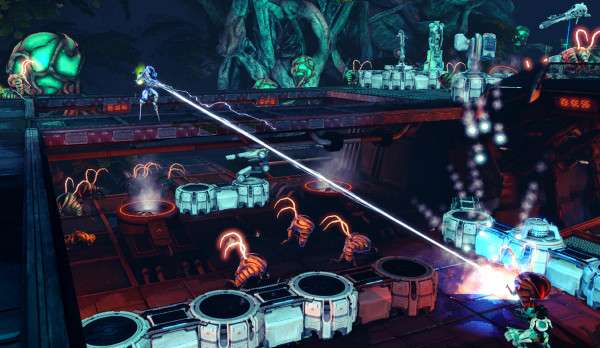
Preview: Sanctum 2
The original Sanctum, which came out in the spring of 2011, was a nice surprise from Swedish developer, Coffee Stain Studios. It took a genre that had been completely burned out – tower defence – and made it exciting and refreshing again by infusing elements from first-person shooters. While the first game wasn’t perfect, it was an enjoyable, if short, game with a lot of heart from a group of now ex-university students. It was a first attempt for the development team, so after a couple of years, Coffee Stain Studios is back with Sanctum 2, along with a promise to step above the original game and make an improved follow-up. DarkZero was offered to spend time with a beta build of the game and came away mighty pleased with the progress made on the sequel so far.
For anyone new to Sanctum, the premise is to protect a power core helplessly placed in your home base from the waves of strange alien creatures who have their eyes set on smashing your luminous, blue energy orb to smithereens. Sanctum 2 is split into two phases. The first is the build phase, in which you are given downtime to place blockades on the ground to hinder the progress of aliens. You cannot completely block the pathways, but you can control where enemies will go, and this is where clever players will manipulate the pathway of the enemy to increase the time it needs to reach the power core. On top of placing blocks, you can also spend credits to buy a variety of towers to place as additional defences. Everything is from the first-person perspective, which might not sound satisfying to do when planning defences, but the handling of deploying barricades and turrets is rather easy to grasp, thanks to the blueprint outline that shows where things will be placed.

Moving on to the wave phase is where you need to have your wits about you. Players need to keep their eyes on the mini-map to see which spawn point is sending out the most menacing enemies. These aliens cover all ranges of attacks, such as the small, fast critters that have a sole purpose of rushing to the core, while the huge, armoured behemoths require you to get behind them to deal damage. Let’s not forget the incredibly annoying flying healers that need to be targeted first to stop them from turning aliens into bullet sponges. There seems to be a large variety of enemies, so to fight them, you are given two weapons to use – a main weapon and a sub-weapon. Both come with infinite ammo, but when the clip runs dry, you are left with a cooldown while the gun reloads. A neat implementation is how the reloading works: Guns are reloaded even when they aren’t equipped, so you can quickly switch to your sub-weapon and keep firing. Normally, by the time you have emptied that gun’s clip, you are able to switch back to the original weapon and fire again. This mechanic offers a way for players to keep in on the action without having to deal with the dreaded reloading and getting caught off guard when the ammo is depleted, which is very handy in a game that sends plenty of enemies in your direction.
Most enemies have a flashing red point placed somewhere on their bodies. These should be the focus of your attacks, as blasting those deals critical damage. All the weapons allow the use of their sight, so you can aim down the barrel for better accuracy. Every gun also has an alternative fire mode, often using more bullets but in turn offering a more damaging attack. The assault rifle’s alt-fire is a grenade launcher, while the energy pistol sends out homing energy balls. The level design is made so that players can easily get around the walls by jumping over them, and bigger enemies can be shot at over the perimeters. Walls are also handy if you want to get away from enemies, as these guys aren’t afraid of attacking, and it can help to put space between yourself and them to let your health regenerate. Killing all the required enemies in a wave rewards with more building blocks and additional money – used to place more towers or upgrade existing defences. Towers range from fast, light machine-guns, to slower, more powerful lightning towers that spark enemies close to each other, to towers that don’t damage but snare the foe in a negative status effect. One thing I noticed in this beta build is that when playing cooperatively (supports up to four players), the rewards given at the end of a wave are not shared between the players, nor do players get their own drops. This means you need to communicate with each other as to who should pick up the money.

Skye Autumn makes her return, and now brings along her little sister Sweet. Skye seems to be the all-around girl, as she has good speed, fast weapons and the ability to double jump, while her sister is the opposite and specialises in explosions. The last two characters are the long-range specialist SiMo, whose rifle makes it easier to hit those glowing red weakpoints, and Haigen, an up-and-close combat master who comes with a shotgun and above-average HP. Along with having unique abilities, a character can alter their sub-weapon, towers and perks, with extra gear that unlocks when you reach specific experience levels on your profile. Perks are handy for situations where you are struggling. For example, if your power core keeps taking damage, equip the 12% regeneration per round. Want to do more damage? Equip the ability to do more critical shots. As a side-note: The developers are no doubt having fun coming up with ideas for perks, as I noticed one of the perks – called plumber boots – references a certain red mascot, and if equipped, it enables your character to deal 5000 points of damage if you jump on an enemy. I never came across any fire flower perks, though.
On release, the first Sanctum only included three maps, but Coffee Stain Studios have stated that 16 maps will be available for the sequel’s launch day. Maps take less time to participate in, as you are no longer surviving 20+ waves, but around 6-11 on average. Even when you are finished with these levels, there are modifiers called “feats of strength” that increase the difficulty but offer more experience points if you manage to complete a stage with them on. Modifiers can alter attributes to make aliens faster, do more damage, increase health, and one even delays a player’s respawn until the wave is over, rather than letting you come back after being dead for ten seconds. There is certainly much more content included in Sanctum 2 over its predecessor.

If there is one thing the studio seems to come off more confident in, it’s the graphics. The sequel still uses Unreal Engine 3, but if you compare the original title with this game, then you can clearly see a better progression in graphics and art. This is no modern-day, brown and orange-colour-schemed shooter; it’s full of vibrant colours that give off a sci-fi vibe with the presentation. Everything about it just seems more polished and I have no doubt this is from the knowledge learnt from creating the last game. Even the controller support is much improved, so for any of you that like couch gaming with a 360 controller will be happy to know that it works perfectly fine.
Sanctum 2 is on the right track to becoming a great follow-up. It fixes the shortcomings of the original by fleshing out the mechanics and systems to play a better game of tower defence meets first-person action. Fans should be excited for this new instalment, and for people who have never played Sanctum, then you might be in for a treat once it arrives for Summer 2013 on PC, with a console version releasing sometime after.